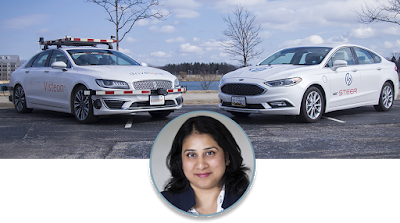Insights on the development of the world’s first Level-4 autonomous parking solution
Guest Blog By Anuja Sonalker, Founder and CEO, STEER

Many of the most popular technological developments in today’s global society have evolved from the inspiration of a single individual, company or breakthrough. Steve Jobs’ iPhone, Mark Zuckerberg’s Facebook, Jeff Bezos’ Amazon all have been seismic innovations that have changed the lives of billions. Advancement of automotive technology, however, rarely has resulted from the vision of just one person. Nearly universally, the vehicles of today and tomorrow represent a “quilt” of exceptional innovations from collaborators, such as those who most recently have come together to advance self-driving technology.
Over the past century, the collaboration of suppliers and manufacturers has been responsible for most of the innovation in our cars and trucks. Today, automated driving is so complex and nuanced that no one entity can resolve all the challenges it represents and be good at creating every aspect of the self-driving vehicle, so collaboration remains essential.
Collaboration and integration have become art forms in the automotive gallery, with a creative supply chain that has enabled the industry to keep up with consumer demand and preferences. Consumers want vehicles to keep pace with their lifestyles just as much as they want a tablet or an online marketplace to reflect their constantly changing needs and tastes. Automotive companies gain this timeliness through collaboration.
Collaborating on driverless parking
One successful example of such collaboration—and one close to my heart—is the work being carried out by Visteon and STEER, the company that I founded. STEER has created the first level 4 fully autonomous parking technology, which transforms everyday cars into driverless vehicles that self-park in designated lots. This technology, activated by a mobile-phone app, lets drivers and passengers be dropped off at their destination; then the car takes over from the drop-off point, navigates and drives itself to a parking area where it detects an open available spot, and parks itself. When they’re ready to leave, they summon their car with the same app. It’s a complete solution that works with existing systems in vehicles and is cybersecure.
Creating this technology, however, is very different from finding a way to integrate it into current and future vehicles and ensure that it works as intended, every time. For that task, we collaborated with Visteon. A few years ago, I met Visteon President and CEO Sachin Lawande, and I was immensely impressed with his vision and his extreme focus on efficient execution, especially in relation to Visteon’s DriveCore™ autonomous driving platform. Visteon had very clear goals and sought out the right team members to pursue them. We were on the same page regarding how to conquer the automated vehicle market.
A success formula on a napkin
In 2016, Sachin and I came up with our formula for integrating STEER and DriveCore™, literally on a paper napkin. DriveCore™ was precisely the right technology for making STEER a practical automotive technology. Its high computational capabilities, robust systems and its ability to support more than 10 sensor channels with Ethernet connectivity are packaged in a very small unit. Moreover, DriveCore™ has enough power to integrate our valet parking system with autopilot technology. These two advancements could be developed independently and then be integrated seamlessly on DriveCore™. This results in a better value proposition for automakers – a bigger solution that is developed more rapidly.
During development, STEER and Visteon together addressed countless edge cases that make automated driving an infinite microcosm of slight differences among driving situations and driver reactions. DriveCore™ has all the features we need to exhaustively prove all the scenarios we must consider now and in the future.
My greatest surprise during this experience was how easy it was to collaborate with Visteon. It’s a large, global company, but one with no bureaucracy to get lost in. Visteon has promptly addressed every need as soon as we’ve identified it.
Our ability to bring STEER to market so quickly speaks to the success of this collaboration. Before long, STEER-equipped vehicles using DriveCore™ technology will roll out in Asia, followed by the U.S. and Europe.
What I have learned from this collaboration process is that, if you run a technology company, first you must focus on getting your niche problem right. Then you need to exceed expectations, and build and test the guts out of it. After that, envision the delivery vehicle for your product to go to market and approach the right partner.
STEER has used this process to transform our expectations into a transformative, practical technology for automated valet parking. We envision more great developments, collaborating with great companies like Visteon. Our next collaborative innovation is just one napkin away.
Anuja Sonalker, Ph.D. is the founder and CEO of STEER Tech, and has nearly two decades of experience in the automotive and cybersecurity industries. Headquartered in Columbia, Maryland, STEER builds products that enable autonomous features in mainstream vehicles, stimulate smart transportation and prevent automotive cyber threats. Dr. Sonalker oversees technology development, navigation of industry landscape and development of go-to-market strategies.
Prior to STEER, Dr. Sonalker was vice president of engineering and operations for TowerSec, an automotive cybersecurity company that was acquired by Harman International in 2016. She was also a project manager within the automotive security group in the cyber innovation unit at Battelle, where she led advanced research in vehicular environments and transition to market strategies.
Dr. Sonalker is currently the vice chair of the SAE Vehicle Cybersecurity Systems Engineering Committee and co-chair of on the ISO International Standard on Cybersecurity Engineering for Road Vehicles.
She holds a Ph.D. in electrical engineering from the University of Maryland College Park, a master of science in computer engineering from North Carolina State University and a bachelor of engineering from the University of Mumbai.

